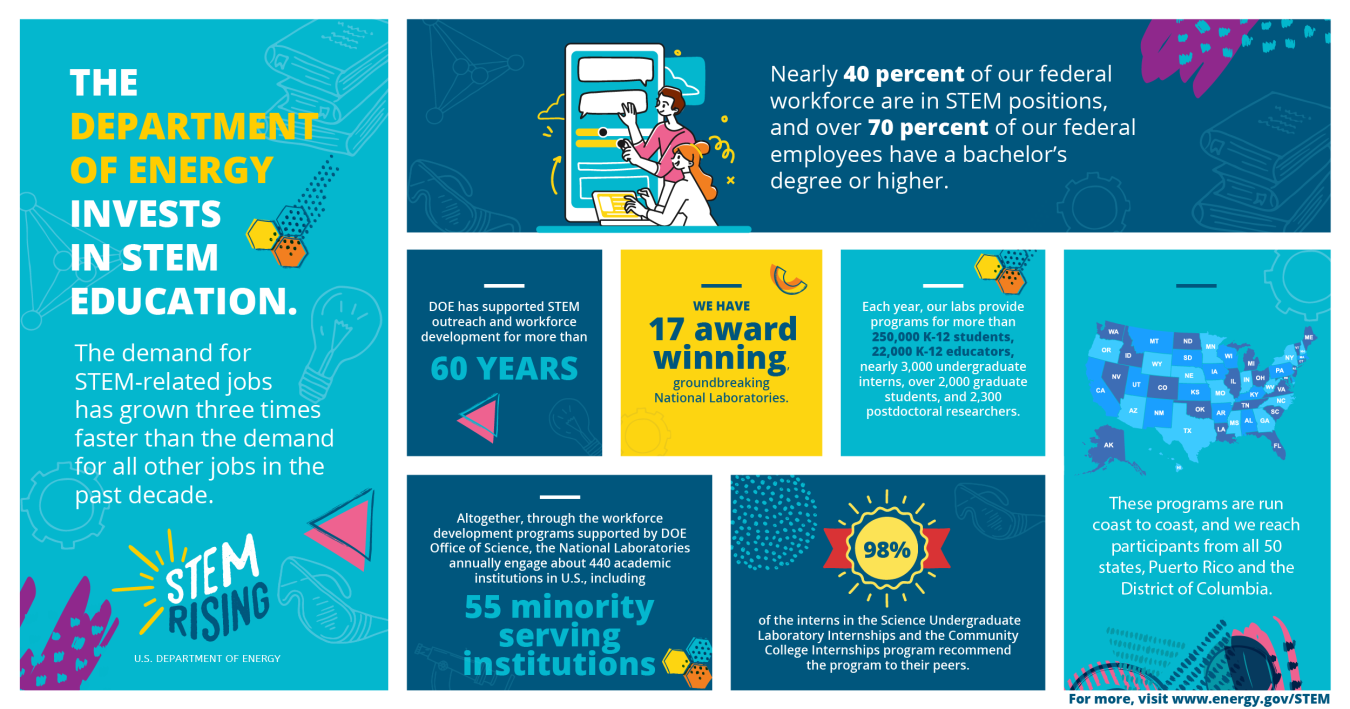Secretary Brouillette discussed STEM with top corporate executives at the Ohio Business Roundtable.
July 21, 2020By Dan Brouillette, Secretary of Energy
The acronym STEM has become commonplace, with science, technology, engineering, and mathematics jobs rising rapidly, paying competitively, and offering exciting and meaningful work opportunities.
That’s why STEM was the topic at hand in Columbus, Ohio, today. I had the pleasure of speaking at the Ohio Business Roundtable with top corporate executives. We all understand that there’s a business bottom-line to ensuring we have the skilled workforce of the future who can take on our toughest STEM challenges. From exploring space and the depths of the ocean to lowering global carbon emissions, our past, present, and future progress comes by way of innovation powered by STEM.
The 21st Century has had plenty of challenges, but has given and will continue to present plenty of opportunities. People in STEM jobs will help find a vaccine for COVID-19, land a rover on Mars, protect our national security, reduce energy waste, and protect our planet for generations to come. There’s been a seismic shift in the labor market, as more positions require specific technical skills and advanced education, and people in STEM strongly recommend it as a career choice.
As I discussed with the participants of the Ohio Business Roundtable, the U.S. Department of Energy (DOE) knows we must ensure we are doing our part to develop a strong STEM pipeline so that these jobs are within reach to all, without barriers from gender, race, financial background, geography, or access.
Each year, through DOE’s 17 National Laboratories, our National Nuclear Security Administration, and our program offices, we reach over 250,000 K-12 students, 22,000 K-12 educators, nearly 3,000 undergraduate interns, over 2,000 graduate students, and 2,300 postdoctoral researchers, in all 50 states, Puerto Rico, and the District of Columbia.

As Danielle Merfeld, Vice President and Chief Technology Officer of GE Renewables said on our C3E International webinar last week, “This is a change that’s going to shift the world, and if we’re an ecosystem that wants to change the world, we should reflect the world.” I’m proud that our agency is engaged with programs like C3E International and a host of STEM events, competitions, internships, teacher development, and digital resources that aim to make our STEM workforce look like our nation.
Exposure to STEM professionals and careers is an important place to start. At DOE’s Portsmouth Site, our annual Science Alliance event brings in over 1,500 high school juniors from the surrounding counties to experience STEM and understand academic requirements related to pursuing these careers. The National Science Bowl, run by our Office of Science, reaches Ohioans in middle school and high school, with a robust competition each year at the South Central Ohio Regional Science Bowl.
We continue to support and develop students as they get ready to enter the workforce, through hands-on experiences such as supporting the Center of Science and Industry's new Learning Lunchboxes program and engaging Ohio students in ongoing opportunities. For instance, our Office of Science’s Community College Internships and Science Undergraduate Learning Internships have had 12,638 participants since FY 2002.
There are hundreds of ways that we’re supporting STEM across the continuum from K-workforce, so be sure to visit our STEM Rising website at www.energy.gov/STEM, and sign up for our monthly STEM newsletter to stay engaged. The future depends on it.
Dan Brouillette
Dan Brouillette, Former Secretary of the U.S. Department of Energy

Dan Brouillette served as the 15th Secretary of the U.S. Department of Energy. Secretary Brouillette has three decades of experience in both the public and private sector. Most recently he was the Deputy Secretary of Energy.
He also served as the Senior Vice President and head of public policy for USAA, the Nation’s leading provider of financial services to the military community. Before joining USAA, Secretary Brouillette was a Vice President of Ford Motor Company, where he led the automaker’s domestic policy teams and served on its North American Operating Committee.
At Ford and USAA, he was part of senior management teams that helped bring to market innovative technologies like auto collision avoidance and remote deposit capture, a technology invented by USAA that allows the use of smart devices to deposit funds into our banking accounts.
Before his transition into the private sector, Secretary Brouillette held numerous positions in government. He was Chief of Staff to the U.S. House of Representatives Committee on Energy and Commerce, which has broad jurisdictional and oversight authority over five Cabinet-level Federal agencies. He also served as Assistant Secretary of Energy for Congressional and Intergovernmental Affairs from 2001 to 2003. In addition, he is a former state energy regulator, having served as a member of the Louisiana State Mineral and Energy Board from 2013 to 2016.
Secretary Brouillette and his wife, Adrienne, are both U.S. Army veterans and have been married for 28 years. They hail from San Antonio, TX, and have nine children.


